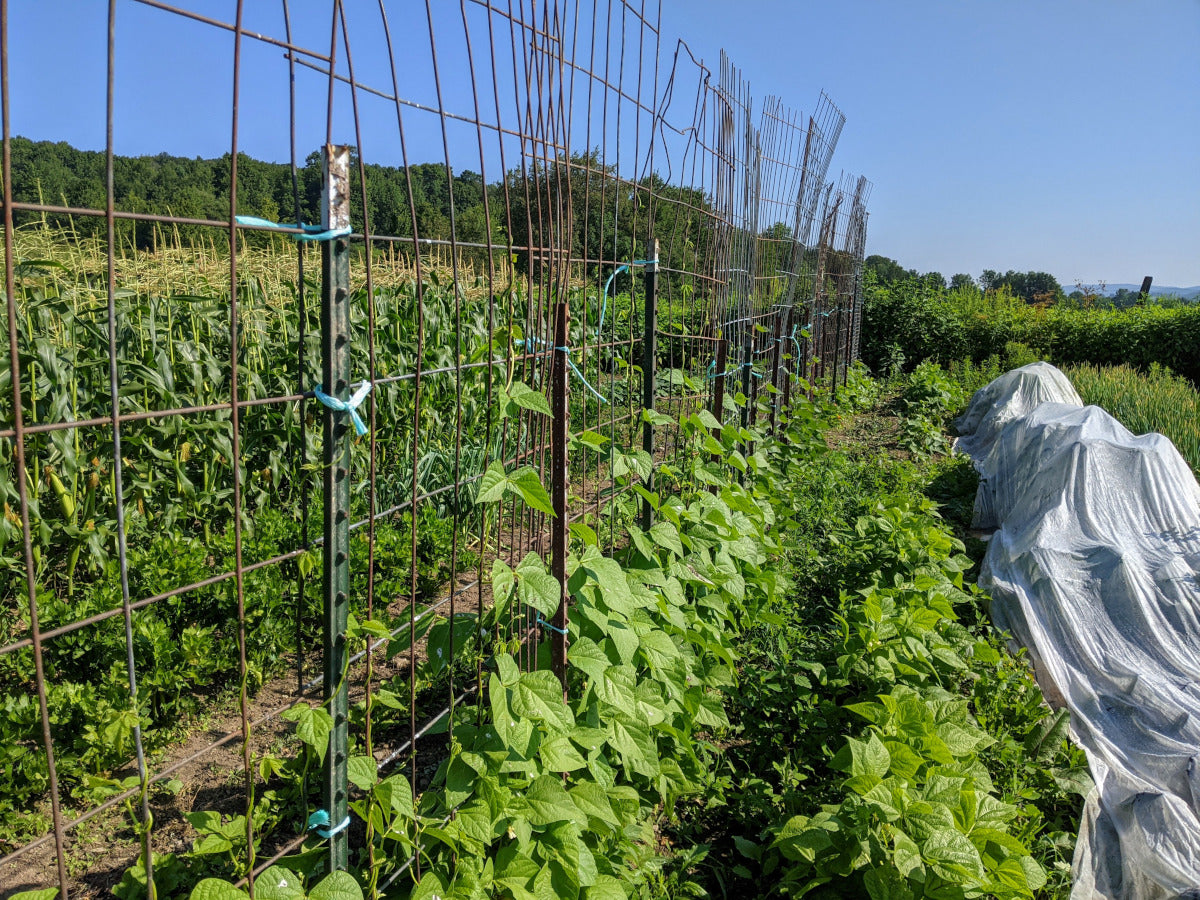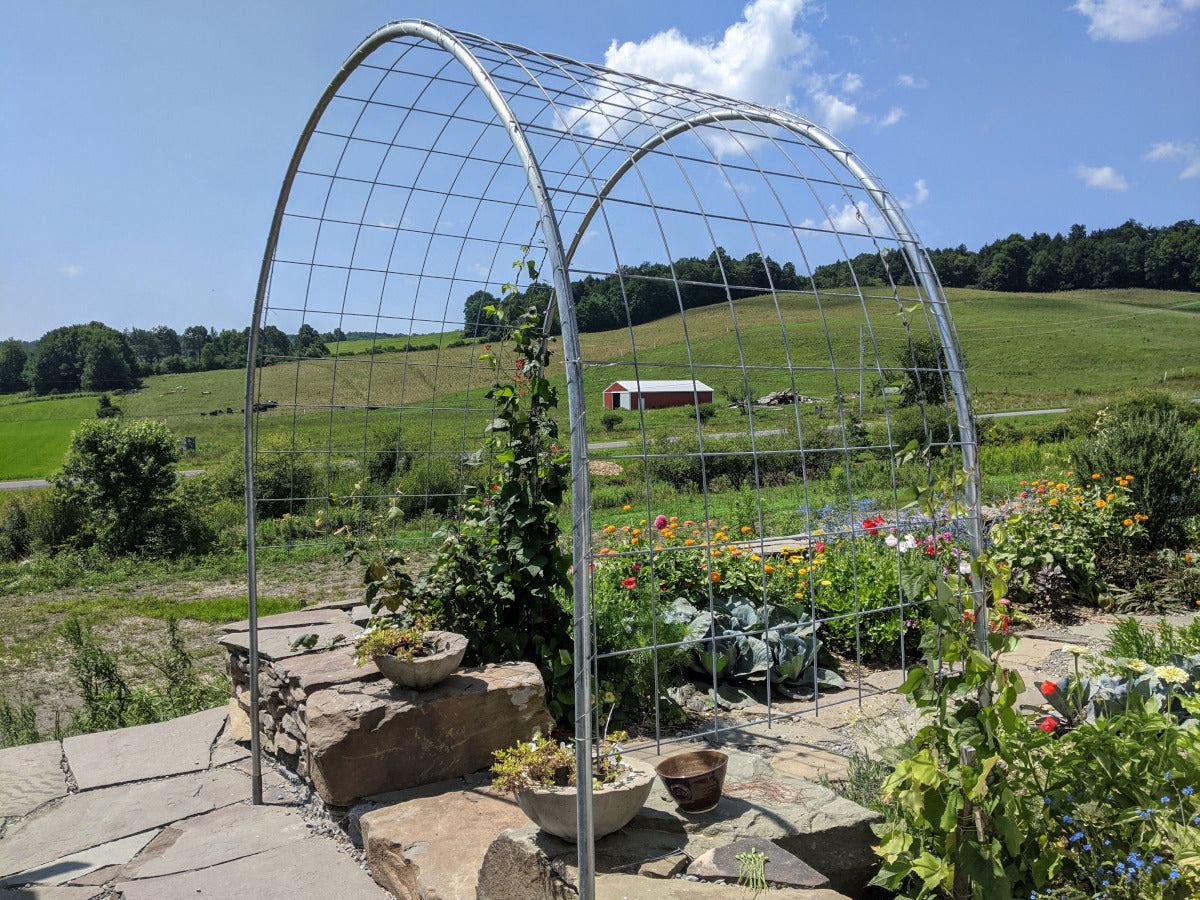Hog Panel Trellis
Hog Panel, Hog Wire, or Cattle Panel: Whatever the Name, It Makes a Great Trellis
About Hog Panels
Also known as "cattle panel" or "hog wire," hog panel is a rectangular sheet of robust fencing commonly used to contain pigs or other livestock. It is made of extremely thick wire, welded together and galvanized. Designed for outdoor farm use, it is very durable, which makes it an ideal trellis material. It can be found in a variety of lengths at Tractor Supply or any other farm supply store.
The durability of hog panel makes it a bit tricky to work with. If you need to cut it bolt cutters work best, but it's better to plan your project to use full lengths if at all possible. Cut ends are very sharp, and doing the cutting takes a bit of elbow grease. The other challenge is getting the panels to your house. If you can design your project to work with 8' lengths, you can borrow your friend's full size pickup or cargo van. But if you want to use a 16' length, I recommend getting the store to deliver, or, if your friend with the pickup also happens to have a flatbed trailer, see if they can haul them for you. While it's possible to bend a full length of hog panel to fit in the bed of a pickup or the back of a van, it is hard to do so safely.
Why Hog Panels Make a Great Trellis
I already mentioned that the rugged design of hog panels makes them a long lasting option for a trellis, and the cost, between $20 and $60 depending on the length and thickness of the wire, is very reasonable given the years or decades of use you can expect. They are rigid enough that they won't sag under even quite heavy plants such as pole beans or cucumbers, and the spacing and thickness of the individual wires that make up the panels are ideal for vines to climb.

Trellis Design
Hog panels are very adaptable. No matter the size of your growing space or the intended aesthetic, you will be able to make something work. The two easiest designs, which I detail below, are the flat trellis, perfect for efficient production, and an arch trellis, which takes a bit more work but can be a lovely addition to either a vegetable or ornamental garden. But you can also be creative. Two pieces of hog panel could be fastened into an A-frame triangle trellis, while four could be used to make a box or even an extremely robust tomato cage. Once you understand the basic principals you can get creative.

Flat Trellis
This design may not be the prettiest, but it is easy to build and harvest from. If you look at the picture above you'll see that the hog panels I use have been around for a long time. They're uneven lengths and widths, but they still work great. If you don't care how it looks you might be able to save money by finding used panels on craigslist. I've oriented the panels vertically since I'm growing pole beans, but you might want them horizontally if you are growing cucumbers or a less aggressive climber.
Equipment list
-Hog panels
-T-posts (at least two per panel)
-UV stabilized zip ties, soft wire, or baling twine
-Ear and eye protection
-Sledge hammer or t-post pounder
-Tape measure
Instructions
1.) Using a sledge hammer of t-post pounder (much easier!) drive a t-post where you want the trellis to start.
2.) If you are orienting hog panels vertically, as in the picture above, use your tape measure to position your next post one panel width away. If you are orienting your panels horizontally, put a maximum of 5' between posts. Repeat until all your posts are set.
3.) Using baling twine, soft wire, or UV stable zip ties, securely attach the hog panels to the t-posts. Take care with this step, since a sloppy job here will weaken the entire trellis.

Arched Trellis Instructions
Arched Cattle or Hog Panel Trellis
Equipment
-
Eye and ear protection
-
Sledge hammer ot t-post pounder
-
Tape measure
Materials
- 1 16' hog or cattle panel
- 4 t-posts
- UV stable zip ties, soft wire, or other fastener
Instructions
-
Lay out a rectangle with the shorter sides the width of the hog panel and the longer sides 5-6'. Drive a t-post in each corner
-
Bend the panel. You want the arch to be confined to the middle 50% of the panel, with a straighter portion on each side. This will make it tall enough to walk through.
-
Securely fasten the arch to the t-posts at each corner using the zip ties, wire, or twine. There should be at least three attachment points on each t-post.
Notes
•If properly made, a panel trellis should be sturdy enough to support any plant. Obvious choice include pole beans or cucumbers, but any climbing plant is a good choice.



